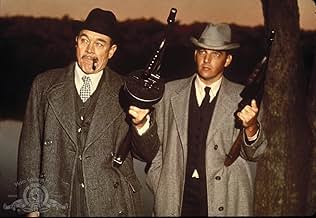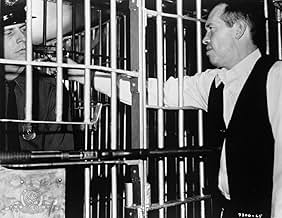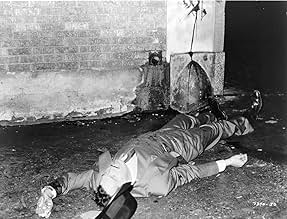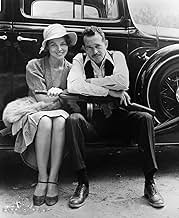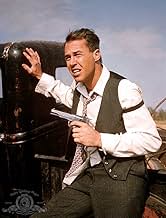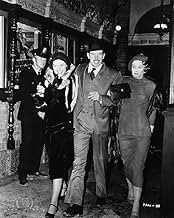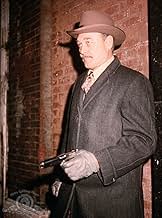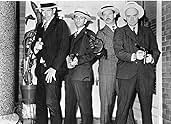IMDb-BEWERTUNG
6,9/10
6286
IHRE BEWERTUNG
John Dillinger und seine Bande begeben sich auf einen Bankraub im Mittleren Westen.John Dillinger und seine Bande begeben sich auf einen Bankraub im Mittleren Westen.John Dillinger und seine Bande begeben sich auf einen Bankraub im Mittleren Westen.
- Auszeichnungen
- 1 Nominierung insgesamt
John P. Ryan
- Charles Mackley
- (as John Ryan)
Jules Brenner
- Wilbur Underhill
- (Nicht genannt)
David Dorr
- Leroy
- (Nicht genannt)
Roland Bob Harris
- Ed Fulton
- (Nicht genannt)
George O. Heath
- John Dillinger, Sr.
- (Nicht genannt)
Empfohlene Bewertungen
One of my all time fave actors played the gun toting thug to the hilt. Also, Ben Johnson was excellent as the obsessive detective dedicated to bringing the hellraising criminal to justice. He did cheat a tad but got the job done with no tears being shed for the hoodlum. Very good action film: I'll never forget the huge cringe I gave when the getaway car ran over a woman and dragged her beneath it for a ways. This was Oates doing some of his best work.
My review might be a little biased because I love Warren Oates and will watch anything he appears in (including obscure movies like 92 In the Shade). However, I'd like to say that this is a very well-made gangster flick that rivals Bonnie & Clyde in entertainment value. I actually prefer the action sequences in Dillinger to the famous ones from Bonnie & Clyde because they seem rougher, more natural and less self-conscious. The shooting sequences in Bonnie & Clyde seem too choreographed and slightly pretentious in comparison. Another selling point for Dillinger is that it contains wonderful performances by Oates and Ben Johnson. Actually, Ben Johnson almost steals the show as "G Man" Melvin Purvis. Even though they only have 1.5 scenes together, Oates and Johnson complement each other nicely here.
John Dillinger (Warren Oates) and his gang go on a bank robbing spree across the Midwest, but one G-Man (Ben Johnson) is determined to bring him down.
Following "Bonnie and Clyde" and "The Wild Bunch", American International Pictures wanted their own violent gangster film. Producer Sam Arkoff hired the then-unknown writer John Milius to construct the script. An earlier, very rough version of the script had come in to producer Lawrence Gordon, and Gordon thought Milius – his former assistant -- would be right for the job.
A little research and a solid script would make this an excellent story, but those involved went one step better. Retired FBI Agent Clarence O. Hurt (1897-1975), one of the agents involved in the final shootout with Dillinger, was the film's technical adviser. Hurt had a distinguished career in the gangster era, also being one of the men who brought in Alvin "Creepy" Karpis. Interestingly, Hurt's house was burgled during his funeral – the newspapers liked to say this was the underworld's belated revenge.
In order to save money (Arkoff was always cutting corners), Milius was also offered the director's chair so that AIP would only have to pay one man rather than two. Gordon says this was his idea, but either way the reason was the same. Milius used John Ford as his inspiration, and if you pay close attention you will see homages to Ford's "My Darling Clementine".
The casting of Oates was pure perfection. Although many actors have portrayed John Dillinger before and since, Oates actually resembles the man for the most part. Singer Michelle Phillips as Billie Frechette, Dillinger's girlfriend, came about by an old Hollywood trick: lying. Phillips had told the producers she was half Indian to land her first acting gig.
Arkoff wrote in his autobiography of the ways they saved money on this one; besides the use of Milius, AIP was also selling off the cars after the shoot. So any money they may have spent during filming was in some way regained, even before the first frame hit the movie screens! The script's attention to facts is impressive. Sure, there are some liberties with Melvin Purvis, having him personally strike down more gangsters than he did. And the Little Bohemia Lodge has a few more casualties than it should have, not to mention some guests who weren't really there. By and large, the changes are minor and can easily be dismissed as a way to make the story simpler and more exciting. Having one FBI agent as the hero rather than a dozen is easily to plot out. At least the plot was not a complete fabrication like "Bonnie and Clyde" was; and still, that film is the one that gets more credit.
Upon release, it was inevitable that "Dillinger" would be compared to other gangster films, especially the identically-named "Dillinger" (1945). Dejan Ognjanovic calls Milius' film "the definitive version of the Dillinger story", and he is right. Ognjanovic also rightly notes that Milius paints his characters as mythical beings, larger than life, though the line between good and evil is often blurry. Carlos Clarens wrote that Milius' version "was considerably more romantic" than the 1945 film, despite the "carefully rigged bullet wounds and spurting blood." If nothing else, "Dillinger" deserves some recognition for its role in history: giving John Milius his directorial debut. AIP, especially through Sam Arkoff and Roger Corman, had given rise to numerous filmmakers from Jonathan Demme to Jack Nicholson to James Cameron. Milius may be lesser-known outside of cinephile circles, but his movies are larger than life: "Apocalypse Now", "Red Dawn" and the under-appreciated "Big Wednesday". Lawrence Gordon's career also took off at this point; his cost-cutting measures landed him a gig at 20th Century Fox, where hewent on to specialize in action films such as "Die Hard" and "Predator".
Arrow Video's 2016 blu-ray release gives this film the royal treatment. We have audio commentary by Stephen Prince, the author of "Savage Cinema" and "Screening Violence" (among others), who is an expert on both the violent film genres and gangster history. We also have brand new interviews with producer Lawrence Gordon, director of photography Jules Brenner, and composer Barry De Vorzon. Not enough? There is also a collector s booklet containing new writing by Kim Newman on fictional portrayals of John Dillinger, plus an on-set report containing interviews with writer-director John Milius, illustrated with original production stills.
Following "Bonnie and Clyde" and "The Wild Bunch", American International Pictures wanted their own violent gangster film. Producer Sam Arkoff hired the then-unknown writer John Milius to construct the script. An earlier, very rough version of the script had come in to producer Lawrence Gordon, and Gordon thought Milius – his former assistant -- would be right for the job.
A little research and a solid script would make this an excellent story, but those involved went one step better. Retired FBI Agent Clarence O. Hurt (1897-1975), one of the agents involved in the final shootout with Dillinger, was the film's technical adviser. Hurt had a distinguished career in the gangster era, also being one of the men who brought in Alvin "Creepy" Karpis. Interestingly, Hurt's house was burgled during his funeral – the newspapers liked to say this was the underworld's belated revenge.
In order to save money (Arkoff was always cutting corners), Milius was also offered the director's chair so that AIP would only have to pay one man rather than two. Gordon says this was his idea, but either way the reason was the same. Milius used John Ford as his inspiration, and if you pay close attention you will see homages to Ford's "My Darling Clementine".
The casting of Oates was pure perfection. Although many actors have portrayed John Dillinger before and since, Oates actually resembles the man for the most part. Singer Michelle Phillips as Billie Frechette, Dillinger's girlfriend, came about by an old Hollywood trick: lying. Phillips had told the producers she was half Indian to land her first acting gig.
Arkoff wrote in his autobiography of the ways they saved money on this one; besides the use of Milius, AIP was also selling off the cars after the shoot. So any money they may have spent during filming was in some way regained, even before the first frame hit the movie screens! The script's attention to facts is impressive. Sure, there are some liberties with Melvin Purvis, having him personally strike down more gangsters than he did. And the Little Bohemia Lodge has a few more casualties than it should have, not to mention some guests who weren't really there. By and large, the changes are minor and can easily be dismissed as a way to make the story simpler and more exciting. Having one FBI agent as the hero rather than a dozen is easily to plot out. At least the plot was not a complete fabrication like "Bonnie and Clyde" was; and still, that film is the one that gets more credit.
Upon release, it was inevitable that "Dillinger" would be compared to other gangster films, especially the identically-named "Dillinger" (1945). Dejan Ognjanovic calls Milius' film "the definitive version of the Dillinger story", and he is right. Ognjanovic also rightly notes that Milius paints his characters as mythical beings, larger than life, though the line between good and evil is often blurry. Carlos Clarens wrote that Milius' version "was considerably more romantic" than the 1945 film, despite the "carefully rigged bullet wounds and spurting blood." If nothing else, "Dillinger" deserves some recognition for its role in history: giving John Milius his directorial debut. AIP, especially through Sam Arkoff and Roger Corman, had given rise to numerous filmmakers from Jonathan Demme to Jack Nicholson to James Cameron. Milius may be lesser-known outside of cinephile circles, but his movies are larger than life: "Apocalypse Now", "Red Dawn" and the under-appreciated "Big Wednesday". Lawrence Gordon's career also took off at this point; his cost-cutting measures landed him a gig at 20th Century Fox, where hewent on to specialize in action films such as "Die Hard" and "Predator".
Arrow Video's 2016 blu-ray release gives this film the royal treatment. We have audio commentary by Stephen Prince, the author of "Savage Cinema" and "Screening Violence" (among others), who is an expert on both the violent film genres and gangster history. We also have brand new interviews with producer Lawrence Gordon, director of photography Jules Brenner, and composer Barry De Vorzon. Not enough? There is also a collector s booklet containing new writing by Kim Newman on fictional portrayals of John Dillinger, plus an on-set report containing interviews with writer-director John Milius, illustrated with original production stills.
Underrated gangster film. No Bonnie & Clyde here but solid cast in good looking fast paced action packed machine gun blazing shoot-em up. Oates is perfect as John Dillinger and Johnson plays a ruthless tough as nails Pervus on his trail. Richard Dreyfuss highlights the supporting cast as the punk Baby Face Nelson. Milius direction style is a combination of Penn and Peckinpah with his fast moving exciting bloody gun battles.
"Dillinger" is one of the best films from Warren Oates. He is better known as a character actor, supporting player and a fine one at that. Occasionally, he was given the lead. The film has great action and Warren Oates bears a striking resemblance to the real life bandit, John Dillinger. Ben Johnson is terrific as the F.B.I agent who is on Dillinger's trail. A minor classic.
Wusstest du schon
- WissenswertesJ. Edgar Hoover protested this film being made and demanded that changes be made to the script to depict the FBI in a better light (see below). Shortly before his death he recorded a disclaimer to the film; it can be heard (spoken by an imitation voice) after the closing credits. The film depicts John Dillinger being shot outside the Biograph after he pulls his gun; in fact, Dillinger never pulled a gun that night. The FBI decided they were going to kill Dillinger rather than attempt to take him alive; they announced their presence, he turned to run, and was shot six times in the back.
- PatzerNotes at the end of the movie claim that Melvin Purvis shot himself with the gun he killed John Dillinger with. In fact, the gun used to self-inflict his fatal wound was given to him by his colleagues at the FBI when he retired in 1935, the year after Dillinger was shot.
- Zitate
[repeated line]
Homer Van Meter: Goddamit! Things ain't workin' out for me today!
- Crazy CreditsAfter the closing credits a verbal renouncing of gangster films written by FBI chief J. Edgar Hoover is heard: he was scheduled to read it for the film, but died before it started production. Hoover's text is read at the film's close by voice actor (Paul Frees) decrying the film and calling it a source of corruption for children.
- Alternative VersionenTwo different versions with different main title music exist_ The original version features the song "We're in the Money" being played while snap shots of homeless and poor people are shown on the screen. The alternate version has the same visuals but with a simpler instrumental cue (called "Theme from Dillinger" on the soundtrack LP).
- VerbindungenFeatured in Breakaway (1990)
- SoundtracksThe Gold Diggers' Song (We're in the Money)
(uncredited)
Music by Harry Warren
Lyrics by Al Dubin
Sung during the opening credits
Top-Auswahl
Melde dich zum Bewerten an und greife auf die Watchlist für personalisierte Empfehlungen zu.
- How long is Dillinger?Powered by Alexa
Details
- Erscheinungsdatum
- Herkunftsland
- Sprachen
- Auch bekannt als
- Dillinger
- Drehorte
- Oklahoma City, Oklahoma, USA(Nightclub for Purvis engagement party; Purvis meets lady in red; Biograph Theater scene where Dilliger dies)
- Produktionsfirma
- Weitere beteiligte Unternehmen bei IMDbPro anzeigen
Box Office
- Budget
- 1.000.000 $ (geschätzt)
- Laufzeit
- 1 Std. 47 Min.(107 min)
- Farbe
- Seitenverhältnis
- 1.85 : 1
Zu dieser Seite beitragen
Bearbeitung vorschlagen oder fehlenden Inhalt hinzufügen


